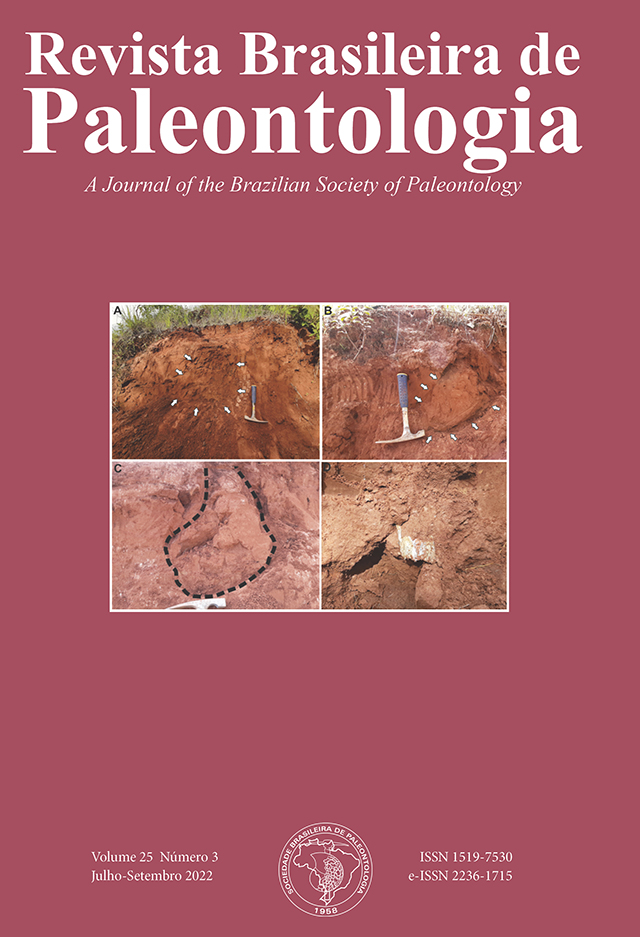Mamíferos del Holoceno de la Provincia de Entre Ríos, Argentina
DOI:
https://doi.org/10.4072/rbp.2022.3.06Abstract
Holocene mammals from Entre Ríos Province, Argentina. We present an unpublished collection of mammals from La Picada Formation (Holocene sensu lato) and San Guillermo Formation (upper Holocene) in the Entre Ríos Province, Argentina, deposited in the collection of the Museo de Ciencias Naturales y Antropológicas “Prof. Antonio Serrano’’ of Paraná City, Entre Ríos. Nine taxa were identified: Dusicyon avus (Carnivora: Canidae), Myocastor coypus (Rodentia: Echimyidae), cf. Hydrochoerus sp. (Rodentia: Caviidae), Dicotyles cf. D. tajacu (Cetartiodactyla: Tayassuidae), cf. Ozotoceros bezoarticus, Mazama sp. (Cetartiodactyla: Cervidae), Bos primigenius taurus (Cetartiodactyla: Bovidae), Equus ferus caballus (Perissodactyla: Equidae) and Cetartiodactyla indet. Ducysion avus and Dicotyles cf. D. tajacu are the first record of these taxa in Entre Ríos. The recognized rodents and cervids are commonly found in archaeological sites and in Quaternary units in Entre Ríos Province. Bos primigenius taurus and Equus ferus caballus are the first findings of post-Hispanic domestic taxa in Holocene sediments from Entre Ríos. The specimen from San Guillermo Formation is the first record of a vertebrate in this unit. Future multidisciplinary studies will be necessary in order to obtain more robust data that will allow us to elucidate the geological and faunistic recent past of the Entre Ríos Province.
Keywords: Quaternary, fossils, South America, Argentinian Mesopotamia.
RESUMO – É apresentada uma coleção de mamíferos procedentes das formações La Picada (Holoceno sensu lato) e San Guillermo (Holoceno superior) na Província de Entre Ríos, Argentina, com base no estudo de antigas coleções depositadas no Museu de Ciências Naturais e Antropológicas “Prof. Antonio Serrano” na cidade do Paraná (Entre Ríos). Foram identificados nove táxons: Dusicyon avus (Carnivora: Canidae), Myocastor coypus (Rodentia: Echimyidae), cf. Hydrochoerus sp. (Rodentia: Caviidae), Dicotyles cf. D. tajacu (Cetartiodactyla: Tayassuidae), cf. Ozotoceros bezoarticus, Mazama sp. (Cetartiodactyla: Cervidae), Bos primigenius taurus (Cetartiodactyla: Bovidae), Equus ferus caballus (Perissodactyla: Equidae) e Cetartiodactyla indet. Dusicyon avus e Dicotyles cf. D. tajacu constituem os primeiros registros destes táxons em Entre Ríos. Os roedores e cervídeos identificados são normalmente encontrados em sítios arqueológicos e, em menor grau, em unidades quaternárias da província. Bos primigenius taurus e Equus ferus caballus constituem os primeiros achados de táxons domésticos pós-hispânicos em sedimentos holocênicos entrerrianos. Do mesmo modo, o espécime procedente da Formação San Guillermo é o primeiro registro de vertebrados nesta unidade. É necessário avançar no estudo da fauna a partir de uma abordagem multidisciplinar, a fim de obter dados mais sólidos para compreender o passado geológico e faunístico recente na Província de Entre Ríos.
Palavras-chave: Quaternário, fósseis, América do Sul, Mesopotâmia argentina.
Downloads
Downloads
Published
How to Cite
Issue
Section
License
Copyright (c) 2022 Revista Brasileira de Paleontologia

This work is licensed under a Creative Commons Attribution 4.0 International License.
This is an Open Access article distributed under the terms of the Creative Commons Attribution-NonCommercial-NoDerivatives license (http://creativecommons.org/licenses/by-nc-nd/4.0), which permits non-commercial re-use, distribution, and reproduction in any medium, provided that no alterations are made and the original article is properly cited. The written permission of Revista Brasileira de Paleontologia must be obtained before any commercial use and/or adaptation of the article.







